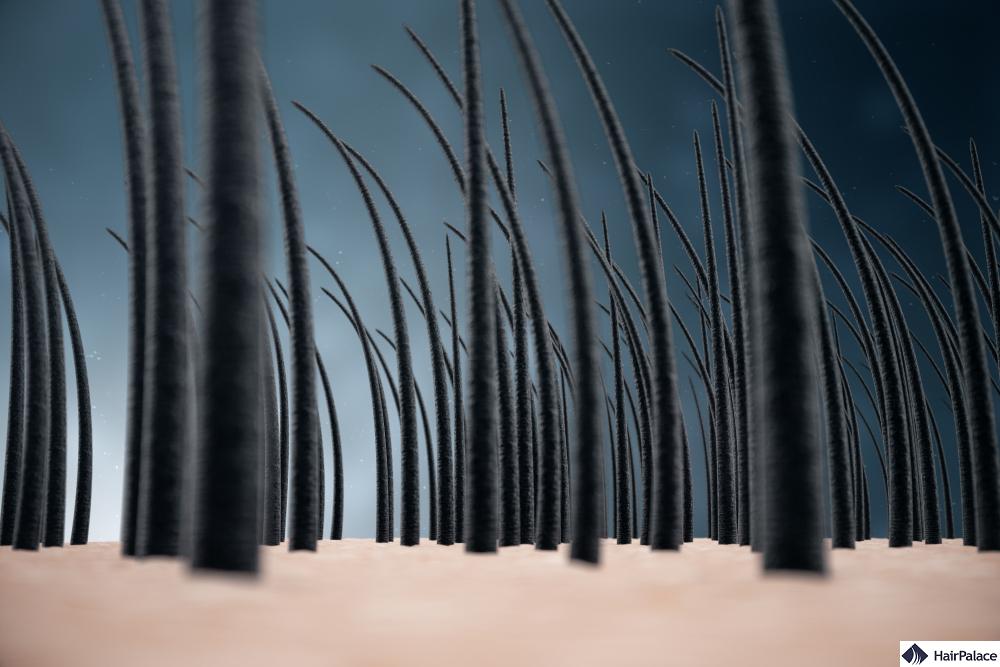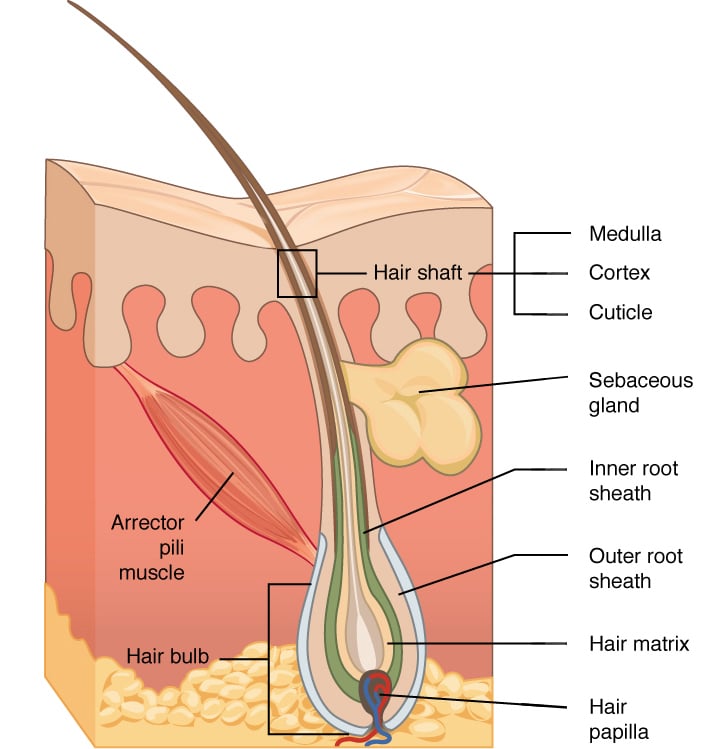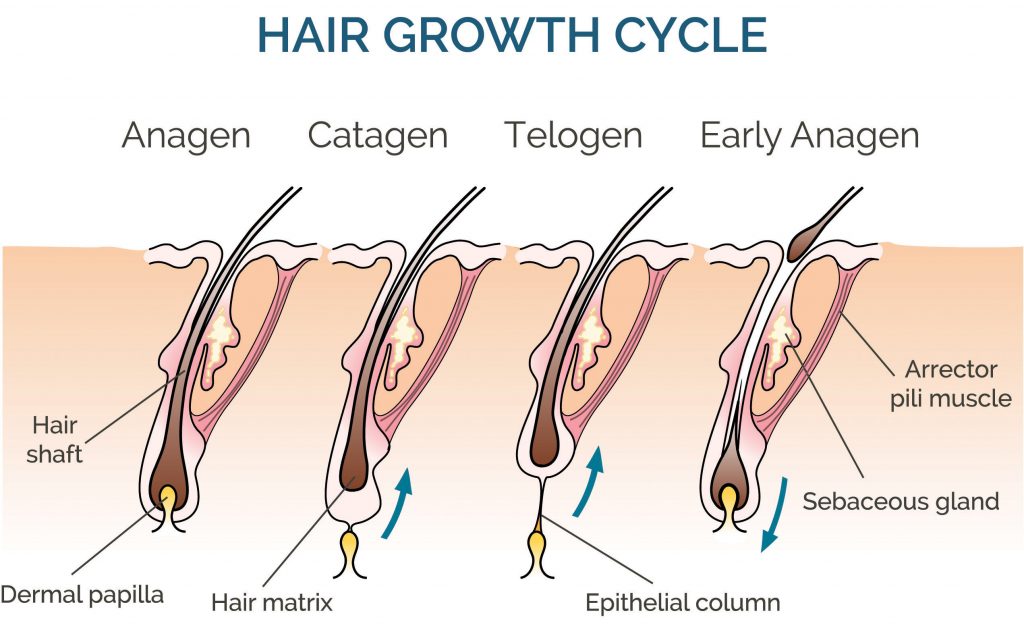Hair Follicle: How Does it Function?

Research states that we have, on average, over 5 million hair follicles across our entire body, with 100,000 on our scalp alone.
A hair follicle is a small structure in the skin responsible for hair growth, consisting of a bulb at the base that contains growth cells and a dermal papilla that supplies nutrients.
Sebaceous glands associated with hair follicles produce oil to condition the hair and skin.
The health and function of a hair follicle is essential for maintaining hair growth and scalp health.
Today, we’ll explore everything you need to know about the human hair follicle.
We’ll touch upon its functions, potential conditions, growth cycle, and ways to stimulate them back into action!
What is a hair follicle?
Hair begins its journey at the follicle, a long shaft found in the outer layer of our skin.
It is microscopic and is the site where hairs sprout from.
The follicle’s base has a blood vessel supply, which nourishes and supports the growing hair.
Over time, the strand slowly rises to the surface of the hair shaft and protrudes from the skin.
The base of the follicle has a supply of blood vessels, which nourish and support the growing hair.
Over time, and as the hair follicle is created, the strand slowly rises to the surface of the hair shaft.
Located inside the follicle are the sebaceous glands.
These produce the natural oil, sebum, which keeps hair and skin moisturized and lubricated.
Together with fat molecules, sebaceous glands also form a coating on the hair that protects it from germs and debris.
Hair follicle structure
To understand our hair, it’s important to understand the structure of the hair follicle.
Despite its small size, the follicle consists of many different parts, each crucial to ensuring hair grows strong and secure.
Hair follicle morphogenesis (development) relies on four essential features:
- Dermal Papilla
The dermal papilla is located at the bottom of follicles and comprises blood vessels, connective tissue, and mesenchymal cells (stem cells).
Together, they nourish strands and ensure a blood supply to the follicle.
- Germinal Matrix
The germinal matrix surrounds the dermal papilla and is the site for new hair growth when old hair dies and falls out.
The germinal matrix is also where melanin is transported to the hair, giving it its pigmentation or hair color.
- Hair Bulb
This is a rounded structure found at the bottom of the follicle, surrounding both the dermal papilla and germinal matrix.
The hair’ root begins here, anchoring the strand to the follicle. The hair bulb is the “living” part of the hair, where cell division occurs.
It also contains hormones that activate at certain life stages, like puberty, to stimulate different hair changes.
- Bulge
The hair bulge acts as a reservoir for epidermal stem cells, crucial to regenerating the hair follicle.
It is found in the middle of the follicle and serves as an insertion point for the arrector pili muscle.
The arrector pili help our skin to regulate heat.

Where are the hair follicles located?
The short answer to this is – follicles are found everywhere.
Wherever there is hair on your body, you will undoubtedly have hair follicles on the skin. But where exactly are they in the body?
Human skin has three layers, and follicles usually originate in the first and second layers (epidermis and dermis).
Some hair grows from the third layer (subcutaneous tissue), such as on our scalp, and terminal hair, such as eyelashes and eyebrows.
The hair growth cycle
There are four different stages to a normal hair growth cycle.
Not all strands are at the same stage, even if they are located near each other.
Let’s take a quick look at how new hair grows at each stage:
1. Anagen (The Growth Phase)
The first stage is the anagen phase, which lasts for 3 to 7 years.
Hair continues to grow until trimmed or falls out on its own accord.
About 85% of hair found on a healthy scalp is in this current growth phase.
2. Catagen (The Regression phase)
In the second stage, hair growth begins to slow down.
The hair follicle shrinks, and the hair shaft separates itself from its base over a few weeks.
3. Telogen (The Resting Phase)
About 15% of hairs on the scalp are in the third stage, known as the Telogen phase.
This resting phase lasts about 3 months and is the period when hair is not actively growing.
Researchers think this period is a particularly crucial phase for hair because a hive of cellular activity happens to stimulate regeneration and prepare the follicle for a return to the anagen phase once more.
4. Exogen (The Shedding Stage)
The fourth and final stage of hair follicle cycling is the exogen phase, which lasts 2 to 5 months.
This is an extension of the telogen stage and sees hair fall out of the root.
Often called club hair, we lose between 50 to 100 strands daily.

How big is a hair follicle?
Follicles are microscopic, so you cannot see them with the naked eye. There are certain things, though, that influence their size.
Different body parts have different-sized cells, e.g., hair follicle cells on your scalp will be different than on your chest.
Secondly, people of different races may have differently-sized and shaped follicles.
Caucasian people, for example, often have elongated follicles that help produce straight or wavy hair.
Black people have curvier-shaped follicles, resulting in tightly curled hair.
What is the function of hair follicles?
Only by understanding the critical function of hair follicles will you go that extra mile to support them.
So what exactly is their purpose?
Think of them as the brains of the hair, responsible for a range of things, including shape and appearance, color, and hair growth.
- Shape
Different follicles produce different hair types, depending on their location.
This is why our scalp hair differs from chest hair, etc. Furthermore, shape defines what texture of hair we grow.
- Colour
Hair gains pigment colour from melanin, which you can find in follicular cells.
There are two types of melanin found in hair; eumelanin and pheomelanin.
A large amount of eumelanin results in black hair, while a medium amount produces brown.
Tiny amounts cause blonde, while pheomelanin makes red hair.
As you grow older, you may be unable to maintain the same level of melanin, leading to greying hair.
- Growth
Follicles regulate hair growth, including the four stages of hair development (Anagen, Catagen, Telogen & Exogen).
On average, hair will grow at around half an inch per month.
Hairs will typically regrow after being pulled from their follicles.
However, a damaged follicle will be unable to grow new hairs. Alopecia and other hair loss conditions can further prevent follicles from functioning normally.
What tests are used to assess the health of the hair follicles?
As with any condition, your doctor will want to examine your scalp closely and consider your health and medical history when diagnosing you.
Some tests are used to get additional information, including:
- Blood test – the primary diagnostic tool used to check hair condition. Tests may involve a complete blood count, an ANA test (to detect autoimmune diseases), and a c-reactive protein test (to check infections and inflammation).
- Biopsy – A small tissue sample is extracted from your skin and sent to a laboratory for microscopic examination.
- Pull test – This simple test sees your doctor pull a section of your hair. They will examine its strength and if and how many strands come out.
Can you stimulate hair follicles to grow new hair?
Hair loss sufferers often wonder if they can regrow hair by stimulating follicles back into action and avoiding invasive procedures.
Unfortunately, damaged hair follicles cannot grow hair; there’s no known way to change this.
That said, research is ongoing. One of the most promising areas is stem cell therapy, which could potentially revive follicles – though further testing is required.
You can keep up to date with the latest information on stem cell hair transplants here.
Presently, the most effective treatment which yields permanent results is hair transplantation.
This is a simple procedure where a specialist transfers healthy follicles strategically into targetted areas suffering shedding or baldness.
These hair follicle implants produce new hair growth over 12-15 months and permanently resolve the issue of baldness.
You can strengthen existing follicles with certain products and treatments, including essential oils, caffeine shampoos, massage therapy, medications like minoxidil, and Platelet Rich Plasma (PRP) injections.
Hair Follicle FAQ
The primary function of a follicle is to grow your hair. The follicle stimulates cell growth and allows for angiogenesis (which creates new blood vessels). They also contain specialized cells which enable them to self-renew, regulate growth and maintain their structure.
Follicles form in the first and second layers of your skin and are made up of several layers of cells originating from basal cells in the epidermis. Hair matrix cells split, creating different layers.
Yes, a follicle can close, leading to permanent hair loss in that area. There are many reasons a follicle might close; the two most common include malnourishment (a lack of vital nutrients) and physical trauma, like repeated hair pulling. Some medications, like minoxidil (known as Rogaine), can react and stimulate dormant follicles. That said, you must continue to use these medications to maintain results.
A follicle is a small tubular cavity in the skin from which hair grows. It’s not easily visible to the naked eye in its entirety because most of it is embedded within the skin. However, the best description is that it’s a narrow tube-like structure.
Painful hair follicles can be caused by inflammation, scalp tension, excessive oil production, product buildup, or infections like folliculitis. Tight hairstyles, stress, or a sensitive scalp can also contribute to discomfort. If the pain persists or is accompanied by hair loss, it’s best to consult a doctor.
To stimulate hair follicles for growth, massage the scalp regularly to improve blood circulation, use essential oils like rosemary or peppermint, maintain a healthy diet rich in vitamins and proteins, and avoid excessive heat or harsh chemicals. Consistent scalp care and proper hydration also support stronger hair growth.
Dead hair follicles are usually not visible to the naked eye, but they may appear as smooth, shiny patches of scalp with no hair growth. Unlike healthy follicles, they no longer produce hair and may show signs of scarring in some cases.
Last medically reviewed on July 14th, 2025
- Heather L. Brannon, MD: The Structure and Growth Cycle of Hair Follicles https://www.verywellhealth.com/hair-follicle-1068786
- National Library of Medicine. Hair Follicle Anatomyhttps://medlineplus.gov/ency/imagepages/9703.htm
- Folliculitis. American Osteopathic College of Dermatologyhttp://www.aocd.org/skin/dermatologic_diseases/folliculitis.html


